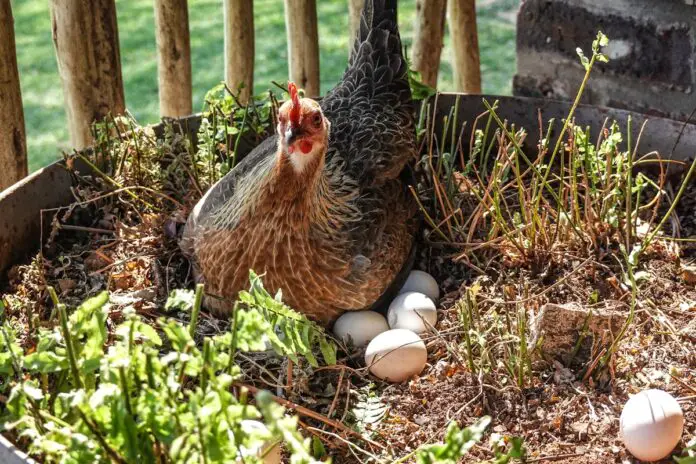Some links on this page may contain affiliate links which means that, if you choose to make a purchase using the link, Agricfy.com may earn a small commission at no extra cost to you. For more information, go to our Affiliate Disclosure Page!
Introduction
Do you want to know the best weather conditions for laying hens? Don’t worry, we’ve got the perfect answer for you. Have you wondered why your hens aren’t laying as many eggs as you’d like?
The health of hens and the quantity of eggs they lay are greatly influenced by the weather when raising them for egg production.
Providing a habitat that closely resembles their natural surroundings is imperative for the hens’ well-being and the caliber of the eggs they lay.
In this guide, we’ll examine the best weather conditions for laying hens, understand how weather affects these clucky friends, and highlight crucial elements that any poultry lover should consider.
Now, let’s explore the several aspects of ideal weather for hen laying.
Different Weather Conditions
Sunny and Warm Weather

For hens, bright, warm weather sets a colorful scene for their everyday lives.
There will be an increase in chicken activity during these bright intervals. They will typically be seen scrubbing around. The increased warmth generally lifts their spirits, resulting in a happier and more energetic flock.
But there’s a downside to everything, just like anything worthwhile. Overheating can cause problems such as heat stress, which can cause chickens to show symptoms of discomfort, including panting.
Managing their surroundings becomes essential to achieve the ideal balance between the bright benefits and any drawbacks.
Cold or Chilly Weather
Remarkably resilient, chickens adjust to these chilly times with their skills.
You will notice behavioral changes in them when the cold sets in. Their method of establishing a warm sanctuary in the cold is fluffing feathers and curling together for warmth.
The coop has a distinct tranquility throughout the colder months, characterized by a slower tempo and a sense of group warmth.
But there’s a warning about the cold. Frostbite becomes an issue, especially on wattles and combs.
The coop becomes a cozy haven from the winter winds when appropriate shelter is provided.
Rainy Weather
Rainy days, albeit cozy for us, provide your laying hens with various exciting and difficult situations.
Chickens go through a distinct form of cleaning in the rain since it’s a natural dust-control mechanism. Rain provides a welcome diversion from the annoyance of pests and parasites.
That being said, moisture follows rain. Without umbrellas, hens might get damp and uncomfortable. The requirement for dry, well-ventilated shelter is highlighted by the rising danger of respiratory problems.
Temperature Needed For Hens To Lay Eggs
Chickens’ ability to produce eggs can be impacted by temperature. Hens may cease laying eggs in the event of an excessive cold. Your hens may stop laying for other reasons, though.
Too Hot to Handle
Your hens may cease laying eggs due to extreme heat or cold. In hens, heat has a greater effect on egg production than cold.
The ideal temperature range for hens to lay in is between 11 and 26 degrees Celsius, or around 52 and 79 degrees Fahrenheit. Its temperature is below, and egg production is reduced.
On the other hand, Hardy winter breeds can continue to lay eggs provided they receive enough nourishment and hydration.
Changes in the Seasons
After hens start laying, they require 14 hours of light per day to continue laying. The light in the Northern Hemisphere declines after the June summer solstice and continues until after the December winter solstice.
Rather than the absence of light, poultry owners frequently believe that their hens’ cessation of laying was due to the dropping temperatures.
Chicken owners can fix this by adding enough artificial light to compensate for the absence of daylight.
What Temperature Is Too Cold?
It may surprise you that hens can tolerate temperatures as low as -20 degrees Fahrenheit. But that only works if your hens are used to those temperatures. Egg production will also be reduced by a relative humidity of 75% or higher.
Your hens will probably suffer more in warmer weather than -20 degrees if you live in a state or nation with high humidity.
However, if a sudden cold snap is predicted, add heat with heat mats or lights.
Hens That Can Handle The Winter
Some breeds of chicken, like the Plymouth Rock, Chantecler, Ameraucana, Australorp, and Buckeye, are recognized for their ability to withstand extremely low temperatures.
Larger-chewing and lighter-bodied birds are often ill-suited to cold climates because their bodies cannot retain warmth, and their combs are prone to frostbite.
Laying Winter Hens
Many wildlife hibernates in the winter, waiting for spring to arrive. Although it is evident that laying hens do not hibernate, many of them drastically reduce or cease their egg production.
If you want your hens to continue laying in the winter, you can, to some extent, trick Mother Nature.
The Right Breed
Buying hens that thrive in the winter is crucial if you reside in a chilly location. Some breeds do not survive the winter well; their combs are readily frostbitten and have greater winter death rates.
Seek out breeds with many feathers, which are adapted to withstand extremely low temperatures. Steer clear of chicken breeds that originated in warm climates.
Araucanas, Australorps, Brahmas, Cochins, Delawares, Hamburgs, and Hollands are well-known breeds resilient to winter and should be considered for your flock.
Remarkably, the naked neck — which does, after all, have a hairless neck — does well in frigid climates.
You can check this article on the best chickens for laying eggs here.
Fewer Eggs
Fewer eggs will be found in the nest boxes as winter draws near. A hen’s age, breed, and temperature all play a role in when she ceases laying for the winter but come springtime, she should resume.
Nevertheless, older hens may stop producing in the spring since they can only lay a certain number of eggs in their lifespan. That probably won’t be a problem if she’s a pet.
Even though they lay fewer eggs, older hens lay larger eggs when they do. Lighting must be installed in the coop and turned on when the days become shorter to trick the birds if you want egg production throughout the winter.
Housing
It is unnecessary to heat the henhouse, even if you may be concerned about your feathered companions outside in the cold. The chickens will get used to the cold.
Therefore, hens that weren’t used to the cold could die if you routinely heated the coop and the heat failed for some reason. Apply petroleum jelly to your hens’ combs to prevent frostbite if you are concerned about it.
Food and Water
In the winter, you may wish to increase the rations your chickens are fed because of the cold. When it gets cold outside, cracked corn can help retain some internal heat in addition to commercial feeding.
Usually, chickens devour it. It is difficult to provide clean, fresh water to your chickens in the middle of winter, but they require it during the day. Installing a heated waterer in your coop is possible if it is equipped with electricity.
If not, remove the waterer during the night when your chickens are roosting and store it somewhere it won’t freeze, or empty it so you can refill it the following day. When the hens get up in the morning, you have to change it.
Lighting Methods For Laying Hens
Having a few hens provides fresh eggs almost year-round—the shorter days during the winter cause egg-laying to slow down or cease entirely.
Using artificial light, your chickens can be cleverly tricked into continuing to produce throughout the season.
Hens require a minimum of fourteen hours of light for them to produce. Your hens should lay more if you give them a 40-watt lightbulb for every 100 square feet of coop space.
Step 1
Determine when additional light is needed. Consider adding extra light for six or seven months, as hens require at least 14 hours of daylight.
Step 2
Use a tape measure to measure the interior measurements of the coop to calculate how many bulbs you’ll need to provide enough light. Multiply the length by the breadth of the coop’s floor space to find the square footage.
A coop measuring ten feet by ten feet is one hundred square feet. Thus, one 40-watt lightbulb can be used in the coop.
Step 3
If you are handy, install the lights; if not, hire an electrician. It is preferable to use a warm light bulb, such as an orange or red one, rather than a blue or colder one, as the warmer light encourages the hen to produce eggs.
Step 4
If you’d like, add a timer. Some owners of backyard hens turn on the lights constantly, while others control them by hand.
The chance of forgetting is reduced when you use a timer, and the hens can experience a cycle of darkness.
If you use a timer, make sure it turns on light during the early, dark hours so the hens can sleep more in the evening.
Effects of Sunlight On Laying Hens

Fall is most likely in the air if your hens produce fewer eggs. For them to continue laying eggs at their best, hens require a specific quantity of daylight.
Egg-laying patterns are altered by even an hour or two of reduced daylight. You can trick Mother Nature into providing fresh eggs all year by adding lighting to your chicken coop.
Sunlight
Hens need roughly 16 hours of sunshine and 8 hours of darkness while roosting to lay eggs reliably. When there are fewer than twelve hours of daylight daily, egg production drastically reduces or stops altogether.
Contrary to popular belief, fewer eggs are laid during the colder months. When daylight hours decrease, even hens raised in warm climates lay fewer eggs.
Synthetic Lamp
Hens should be laid all year round with about 40 watts of light per 100 square feet of the henhouse. Because incandescent bulbs’ wavelengths are closer to those of natural sunshine, they should be used instead of fluorescent lights.
Set the light bulb to turn on during the dark hours of the morning instead of at night by setting a timer. A timer should be set so the hens will only experience eight hours of darkness.
For instance, you could program the timer to turn on the light at two in the morning if the sun sets at five o’clock.
The Impact of Weather On Hens
Let’s now examine how the weather impacts our clucky friends’ bodily well-being.
Physical Health
Severe weather can be dangerous. Despite having feathers, chickens are nonetheless susceptible to the weather and can experience heat stress in hot conditions.
Heat-seeking hens may pant excessively in hot weather, spreading their wings widely to release heat.
Stress like this might cause decreased egg production and, in severe cases, even death if it is not treated right away.
On the other hand, frostbite becomes a serious risk at really low temperatures. Freezing temperatures can harm chickens, especially their combs and wattles.
To minimize these weather-related health risks, adequate shelter, ventilation, and access to clean water are essential.
Consider it as giving your feathered companions a warm and comfortable haven that is furnished with enough shade in the summer and enough insulation in the winter.
Changes in Behavior
The weather influences our clucking friends’ behavior in addition to variables like temperature and precipitation. Imagine yourself on a dismal, rainy day; you could be a little more sluggish and looking for cover. That also applies to chickens.
You may observe alterations in their typical behaviors during extreme weather, regardless of the temperature. Chickens that lack energy may lay fewer eggs during heat waves because their bodies must redirect energy to withstand extreme temperatures.
Conversely, in colder climates, they may bundle themselves to be warm and save energy that would otherwise be used to produce eggs.
To give the best care possible, it is essential to comprehend these behavioral changes. Your feathery companions may easily navigate these weather-induced behavioral shifts if you provide extra shade, adequate ventilation, or heat sources.
Factors to Consider for Optimal Weather Conditions
Housing and Shelter
Living in a house that can’t keep you safe from the weather is not a pleasant idea. The same is true with chickens. Their well-being in various weather situations greatly depends on the materials and design of their coop.
Properly shaded coops with good ventilation are crucial in warm weather. Think about elements such as cross-ventilation windows and solar-reflecting materials.
Conversely, insulation becomes a hot topic in colder climates. Chicks can find a warm and comfortable place to live on cold evenings in an insulated coop that is ideally raised to prevent drafts.
Recall that contented hens are productive ones, and their happiness largely depends on their coop’s architecture.
Nutrition
Like humans, chickens have dietary requirements that might change depending on the weather. They might require an increase in electrolytes to stay hydrated and maintain their health during periods of intense heat.
On the other hand, during the winter months, a diet that is marginally higher in fat can supply the additional energy required to fend off the cold.
Access to clean, fresh water is just as important to proper nutrition as the feed used. It is important to have weather-resistant water sources because dehydration can occur in both hot and cold temperatures.
Breed Considerations
Like people, chickens have varying climatic preferences and come in various forms, sizes, and feather types. While many varieties do well in the heat, others can withstand extremely low temperatures.
Select chicken breeds that are appropriate for your local climate by taking that into account. By doing this, you can be sure your feathery companions will be more prepared to withstand the weather with less anxiety.
Health Management
The health landscape for hens is impacted by weather and the physical environment. Humidity can facilitate the growth of germs and raise the risk of respiratory problems.
A good preventive care plan that addresses the unique risks presented by the current weather conditions should be implemented in addition to routine examinations and immunizations.
Conclusion
Creating the best weather conditions for laying hens involves understanding and managing various factors.
From temperature control to ensuring proper ventilation, attention to detail in the coop’s design and maintenance significantly impacts the health and productivity of your hens.
By ensuring a comfortable environment, you promote optimal egg production and contribute to the overall well-being of your feathered friends.
I hope you found this article helpful and actionable. Please share your thoughts with us in the comment section below.
Also, you can read more related articles by visiting our home page.
